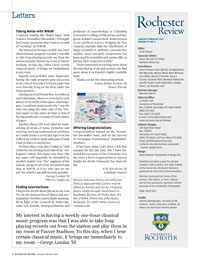Letters
I enjoyed reading the “Radio Days” item (Letters, November-December). It brought back many memories that I had as a result of “working” at WRUR.
My interest in having a weekly one-hour classical music program was that I was able to take long-playing records out from the station and play them in my room at Fauver Stadium. To this day, when I hear certain classical music, it brings me immediately to my room.
Equally and probably more important, having the radio program gave me access to the rolls of discarded Teletype paper that were literally lying on the floor under the Telex printers.
Having survived World War II in Siberia and Uzbekistan, where we were lucky to be able to write in the white space of newspapers, I could not understand why I was the only one using the other side of the Teletype paper to take notes in class in lieu of buying notebooks or reams of white sheets of paper.
Further, these rolls were ideal for memorizing all kinds of dates, formulas, and working out long mathematical problems as I could create a scroll and tape it on the walls of my room to study each part of what I had to learn or memorize.
In those days, I was also a waiter at Todd Union for the evening meal. One of my “colleagues” whose first name was Dave (the last name will hopefully be identified by another reader) was “the” engineer of the station. He spent all of his extracurricular time at WRUR. It is he who “got me the job” for which I am still eternity grateful.
George Landau ’55
Tiburon, California
Finding Intersections
I found the article about physicist Jay Last ’51 (“At the Intersection of Optics and Art,” September-October) particularly meaningful in light of the research by Nobel laureate Eric Kandel, neuropsychiatrist and professor of neurobiology at Columbia University’s College of Physicians and Surgeons. Kandel’s recent book, Reductionism in Art and Brain Science: Bridging the Two Cultures, explains that the “distillation of larger scientific or aesthetic concepts into smaller, more tractable components has been used by scientists and artists alike to pursue their respective truths.”
Those interested in learning more about the interfacing of art and science can find more about it in Kandel’s highly readable book.
Thank you for this interesting article.
Arlene Eichen Stolnitz ’56
Venice, Florida
Offering Congratulations
Congratulations indeed on the November-December issue, and on the success of “A Campus Transformed” (September- October).
It has been many years since I left that campus for the last time, but I have followed the successes of the University over the years. I feel it is appropriate to express thanks for all the University has done for me.
F. H. Kim Krenz ’41
Lakefield, Ontario
Review welcomes letters and will print them as space permits. Letters may be edited for brevity and clarity. Unsigned letters cannot be used. Send letters to Rochester Review, 22 Wallis Hall, P.O. Box 270044, University of Rochester, Rochester, NY 14627-0044; rochrev@rochester.edu.

